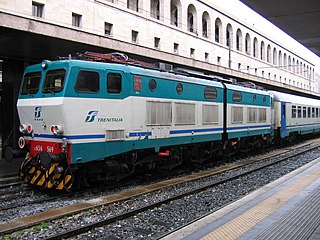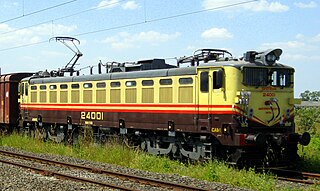
A Bo-Bo-Bo or Bo′Bo′Bo′ is a locomotive with three independent two-axle bogies with all axles powered by separate traction motors. In the AAR system, this is simplified to B-B-B.
B-B and Bo-Bo are the Association of American Railroads (AAR) and British classifications of wheel arrangement for railway locomotives with four axles in two individual bogies. They are equivalent to the B′B′ and Bo′Bo′ classifications in the UIC system. The arrangement of two, two-axled, bogies is a common wheel arrangement for modern electric and diesel locomotives.

The WAG-9 is a type of electric locomotive used by the Indian Railway It was the most powerful freight locomotive of its fleet until the formal induction of the WAG-12. It is similar to the WAP-7 class locomotive but features a different gear ratio, which makes it suitable for heavy freight operations. In November 1998, the Chittaranjan Locomotive Works (CLW) started producing these with indigenous components. The first of which, named Navyug , was produced on 14 November 1998. Like the WAP-5 units, the WAG-9 has GTO thyristor converters and three-phase asynchronous motors.

The WAG-5 is a type of electric locomotive used in India. It was once the second most widely used locomotive in the Indian Railways, with a total of 1197 units built including variants. WAG5A is the one with Alstom traction motors. WAG5B is a converted WAM4. WAG5H(x) is with Hitachi traction motors. WAG5P(x) is a passenger dedicated class. WAG5(x)D are fitted with dual brakes and WAG5(x)E are fitted with air brakes. WAG5RH and WAG-5HR are fitted with Rheostatic or Friction braking. Another variant is WAG-5HG.The units with additional '6P' markings have all parallel grouped traction motors. WAG-5HB is built by BHEL. Some units are fitted with Static Converter(STC), Microprocessor, Dynamic brake resistors(DBR) and SI unit. Due to the advent of WAG-7 and WAG-9, these locos except WAG-5HA/HB are even used for passenger trains although it is a freight-dedicated locomotive. WAG-5HB is homed at Jhansi shed near BHEL's installations for maintenance purposes. WAG-5 has a shell of WAM-4. Units numbered till 23293 have side Louvre and round glass windows like WAM-4 and units after 23293 have WAG-7 style of Louvre for better ventilation. Recently, WAG-5 have been fitted with data loggers. Unit numbered 23026 was selected by RDSO for adoption of thyristor controlled electricals in 1995. This was done due to the loss of suppliers of tap changer control. Project began in 1992. The new prototype system built in collaboration with Bhabha Atomic Research Centre was fitted in the locomotive between 1997–98. However, due to several problems like interference with signalling equipment, the project was ceased in 1999. The engine was rebuilt to original WAG-5 and designated as WAG-5P.

The Indian locomotive class WAM-4 is a class of 25 kV AC electric locomotives that was developed in the 1970 by Chittaranjan Locomotive Works for Indian Railways. The model name stands for broad gauge (W), AC Current (A), Mixed traffic (M) engine, 4th generation (4). They entered service in March 1971. A total of 500 WAM-4 were built at CLW between 1970 and 1983, which made them the most numerous class of mainline electric locomotive till its successor the WAG-5.

The EMD GT46PAC or WDP4 is a passenger-hauling diesel-electric locomotive with AC electric transmission designed by General Motors Electro-Motive Division and built by both GM-EMD and under license by Diesel Locomotive Works (DLW) of Varanasi, India for Indian Railways as the classes WDP4, WDP4B and WDP4D. The GT46PAC is a passenger version of the previous Indian Railways EMD GT46MAC freight locomotive. The locomotive has a 16-cylinder 710G3B diesel engine and is one of the fastest diesel-electric locomotives in service in Indian Railways.

The Deutsche Reichsbahn Class 250 is a German electric locomotive used on freight trains. Nicknamed the “Electric Container” or “Powercontainer” due to its distinctive carbody shape. It was the most powerful locomotive in the former GDR and is still in use at the Deutsche Bahn AG.
Aurizon electric locomotives are used by Australian rail operator Aurizon in Queensland.

The VL85 is a Soviet built electric mainline freight locomotive manufactured at the Novocherkassk Electric Locomotive Plant (NEVZ) and designed under the management of V.Ya.Sverdlov (ru:В.Я.Свердлов).

WCAM–3 is a class of dual-power AC/DC series locomotives used in the Indian Railways system. They are the third of the WCAM series. They were specifically designed for use by Central Railways in the Ghat section towards Nashik and Pune.

The BB 13000 class were electric locomotives operated by SNCF in France. They were one of four classes, together with the BB 12000, CC 14000 and CC 14100 classes, that formed an experimental group for studying the practicality of the new French 25 kV 50 Hz AC electrification.

The Indian locomotive class WAM- 2/3 is a class of 25 kV AC electric locomotives that was imported from japan in 1960s for Indian Railways. The model name stands for broad gauge (W), AC Current (A), Mixed traffic (M) engine, 2nd (2). A total of 38 WAM-2/3 locomotives were built by The Japanese Group between 1960 and 1964. They entered service in 1960.

WCAG–1 is a class of dual-power AC/DC series locomotives used in the Indian Railways system. They are the only class of the WCAG series. They were specifically designed for use by Central Railways in the Ghat section towards Nashik and Pune.

The Indian locomotive class WAG-1 is a class of 25 kV AC electric locomotives that was imported from Europe in 1960s for Indian Railways. The model name stands for broad gauge (W), AC Current (A), Goods traffic (G) engine, 1st (1). A total of 112 WAG-1 locomotives were built by The European Group 50Hz Group/European Group/50 Cycles Group (consortium) between 1963 and 1966. They entered service in 1964.

The Indian locomotive class WAG-2 is a class of 25 kV AC electric locomotives that was imported from japan in 1960s for Indian Railways. The model name stands for broad gauge (W), AC Current (A), Goods traffic (G) engine, 2nd (2). A total of 45 WAG-2 locomotives were built by The Japanese Group between 1964 and 1965. They entered service in 1964.

The Indian locomotive class WAG-3 is a class of 25 kV AC electric locomotives that was imported from Europe in 1960s for Indian Railways. The model name stands for broad gauge (W), AC Current (A), Goods traffic (G) engine, 3rd (3). A total of 10 WAG-3 locomotives were built by The European Group 50Hz Group/European Group/50 Cycles Group (consortium) in 1965. They entered service in 1965.
The Indian locomotive class WAG-4 is a class of 25 kV AC electric locomotives that was manufactured by CLW in late 1960s for Indian Railways. The model name stands for broad gauge (W), AC Current (A), Goods traffic (G) engine, 1st (1). A total of 186 WAG-4 locomotives were built by The European Group 50Hz Group/European Group/50 Cycles Group (consortium) between 1967 and 1969. They entered service in 1967.

The Indian locomotive class WAG-6A is a class of 25 kV AC electric locomotives that was developed in the 1988 by Allmänna Svenska Elektriska Aktiebolaget (ASEA) for Indian Railways. The model name stands for broad gauge (W), AC Current (A), Goods (G) engine, 6th generation (6) First variant (A). They entered service in 1988. A total of 6 WAG-6A were built at ASEA, Sweden between 1987 and 1988. they were the most powerful locomotives in India until the arrival of the WAG-9 class.

The Indian locomotive class WAG-8 is a class of 25 kV AC electric locomotives that was developed in the 1990s by Bharat Heavy Electricals Limited (BHEL) for Indian Railways. The model name stands for broad gauge (W), AC Current (A), Freight traffic (G) engine, 8th generation (8). They were only prototypes locomotives.

The Indian locomotive class WAG-6B/C is a class of 25 kV AC electric locomotives that was developed in the 1988 by Hitachi for Indian Railways. The model name stands for broad gauge (W), AC Current (A), Goods (G) engine, 6th generation (6) Second/Third variant (B/C). They entered service in 1988. A total of 12 WAG-6 were built at Hitachi, Japan between 1987 and 1988. they along with WAG-6A were the most powerful locomotives in India until the arrival of the WAG-9 class.
































